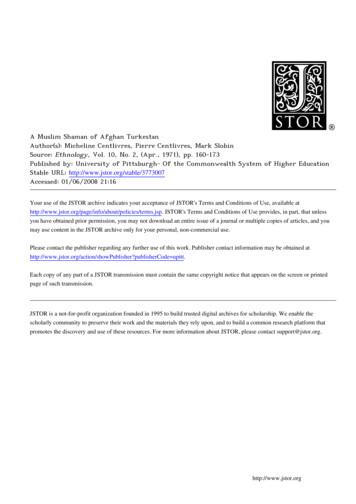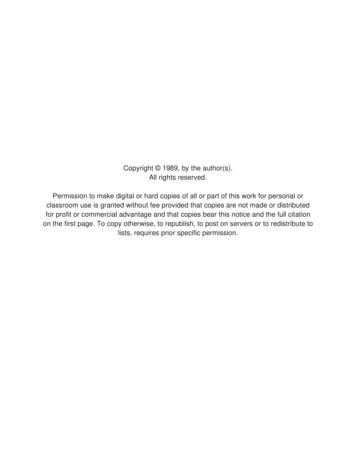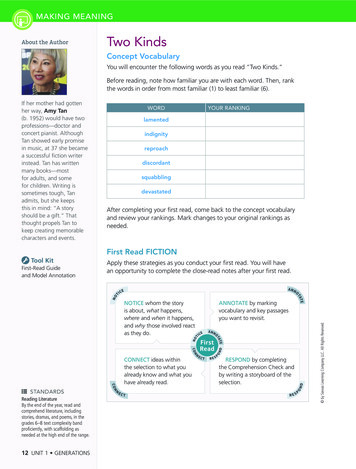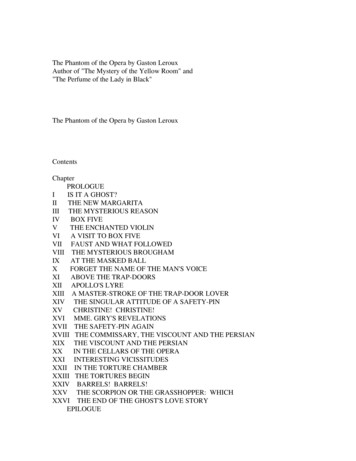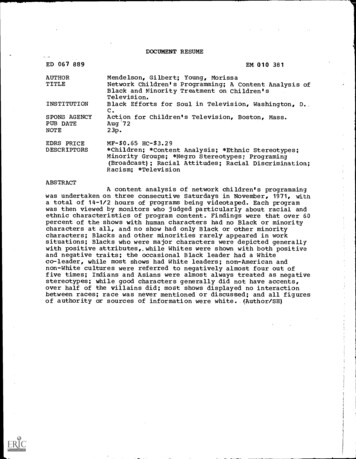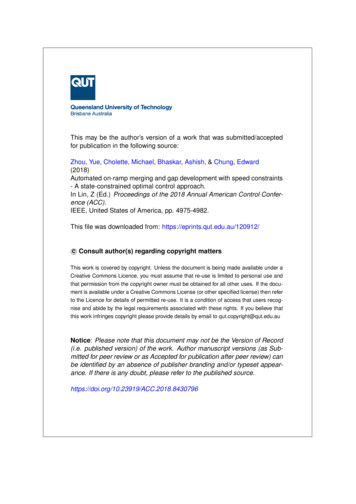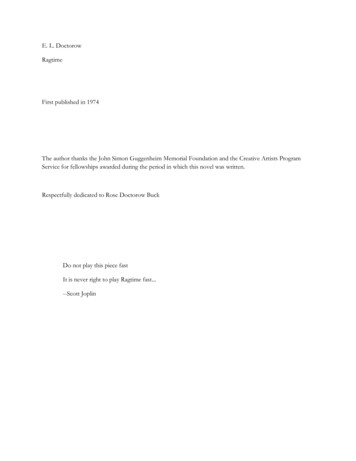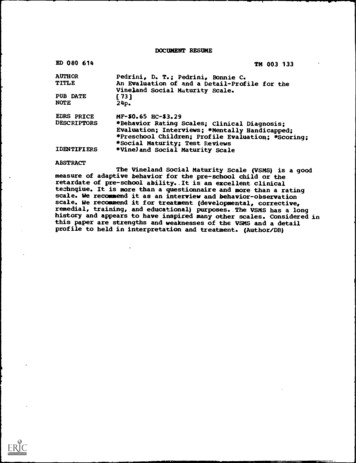
Transcription
DOCUMENT RESUMEED 080 614AUTHORTITLEPUB DATENOTEEDRS PRICEDESCRIPTORSIDENTIFIERSTM 003 133Pedrini, D. T.; Pedrini, Bonnie C.An Evaluation of and a Detail-Profile for theVineland Social Maturity Scale.[73]24p.MF-80.65 BC-83.29*Behavior Rating Scales; Clinical Diagnosis;Evaluation; Interviews; *Mentally Handicapped;*Preschool Children; Profile Evaluation; *Scoring;*Social Maturity; Test Reviews*Vineland Social Maturity ScaleABSTRACTThe Vineland Social Maturity Scale (VSMS) is a goodmeasure of adaptive behavior for the pre-school child or theretardate of pre-school ability.It is an excellent clinicaltechnqiue. It is more than a questionnaire and more than a ratingscale. We recommend it as an interview and behavior-observationscale. We recommend it for treatment (developmental, corrective,remedial, training, and educational) purposes. The VSMS has a longhistory and appears to have inspired many other scales. Considered inthis paper are strengths and weaknesses of the VSMS and a detailprofile to held in interpretation and treatment. (Author/DB)1
FILMED FROM BEST AVAILABLE COPYRIU S DEPARTMENT OF HEALTH.EDUCATION WELFARENATIONAL INSTITUTE OFEDUCATIONTHIS DOCUMENT HAS BEEN REPRODUCED EXACTLY AS RECEIVED FROMAN EVALUATION OF AND A DETAIL-PROFILE FORTHE PERSON OR ORGANIZATION ORIGINATING IT POINTS OF VIEW OR OPINIONSSTATED DO NOT NECESSARILY REPPESENT OFFICIAL NATIONALINSTITUTE OFEDUCATION POSITION OR POLICYTHE VINELAND SOCIAL MAInITY SCALED. T. Pedrini and Bonnie C. PedriniUniversity of Nebraska at Omaha, Omaha, Nebraska 68101AbstractThe Vineland Social Maturity Scale (VSTIS) is a good neasure of adantivebehavior for the pre-school child or the retardate of nre-schoolability.It is an excellent clinical teChnioue.and more than a rating scale.behavior-observation scale.It is more than a questionnaireWe recommend it as an interview andWe recommend it for treatment (developmental,corrective, remedial, training, and educational) nurposes.The VSMShas a long history x 4 annears to here inspired rani other scales.CI)sidered in this naner are strengths and weaknesses of the VSMS andaCe,.)detail profile to help in i.ternretation and treatment.Contents follows.A Table ofCon-
AN EVALUATION 0/' AND . DI:TM-PROFILE l'ORTHE VINELAND SOCIAL MATUPITY SCALETeb]e of ContentsPage-NumberIntroductionInterviet,ing and Scoring337StandardizationItems and Categories912Language Stereotypes12VT'S and Other Scales13Sca.er and Profiles17Reference r,Table I, Suggested Order of DiscussionWithin and Among VS!'S Areas21Table 2, Vineland Age Scale: Items.22and ScoresTable 3, Detail Profile: VSPS Areas,Items, Scores, and Corresponding SA'sTable 4, Detail Profile (continuation)2324
13AN EVALUATION OF AND A DETAIL-- PROFILE FOReTHE VINELAND SOCIAL MATURITY SCALEDoll (1947, 1953, 1965) in his Vineland Social Maturity Scaleattempts to measure social maturity, intelligence, and competency.Thistechnique has a history of indebteAness (Doll, 1953,4pp. 4-0), but nonetheless made a unique contribution in the year it was first published(Doll, 1935a, 1935b, 1935c).Personal-social maturation is an area ofcritical importance vhen one works with children and/or retardates.The American Association on Mental Deficiency in earlier Manuals (Heber,1959, 1961b) and esnecially in its current Manual (Grossman, 1973,pp. 11-21) stresses the imnortance of adaptive behavior in an evaluationof retardation.Heber (1961b, p. 61) further states that "The VinelandSocial Maturity Sc%le is perhaps the best single measure of AdantiveBehavior currently available."This was undoubtedly true, thoughother scales are nog available and are being researched (!pros, 1961,11965, 1972).Interviewing and ScoringThe VSMS may bz. administered according to standard procedures(Doll, 1953, Dn. 266-283, et Passim) or accordinR to special procedures(Doll, 1953, pp. 291-298, 471, et passim).If administered accordingto special procedures, Doll (1953, n. 291) says, ".such resultsshould be cautiously interpreted since normative data and correlativeevidence on reliability, validity, and nrobable error of measurementhave not yet been systematically established."Denartures from standardarlinge.
4procedures, then, should be avoided if Possible.The standard procedurementioned by Doll (1153, nn. 347 -358) in his normative standardization(n 629) did not appear to include the presence of the subject uncle::discussion.Therefore, Doll (1947; 1953, pn. 3, 268, 449, 459; 1965)not only allows the examination of a subject in absentiaindirect examination), but he recommends it.(also calledIn fact, he states that".to know or to see the subject.usually nrejudices the examination."(Doll, 1953, p. 268)This is possible, but hopefully the skilledexaminer should have had better training and education, and if so couldturn his knowledge to advantage.of true and/or error variance.Also, the informant is a major variableHow is one to differentiate?byascertaining the Enowledpeabilitv (validity?) and veracity (reliability?)of the informant:flow many tines have we heard, "Oh, I didn't know heAnd, informants are usually emotionally involved withcould do that."the subjects and many lose their objectivity.otherwise.We should not expectInternal consistency procedures (within the Scale) arehelnful, but external consistency procedures (seeing the subject perform) are better.The informant and/or the interviewer can work withthe subject and thereby improve the data collection.After all, weare interested in what the subject does, and not just what the informantsays he does.The "burden of nroof" is on the intervIew:r.Doll (1953, pn. 271-276) gives a few good examples of interviewdiscussion, and that format should be followed in questioning.AVineland interviewer would do well to formulate general-discussionquestions dealinfl with snecific series of items.This technique iseasier to learn by example, rather than by precept.(See Table 1.)
5An annroximate level for discussion may he quickly established inan area (or category) denending unon anparent (verbal-informant orperfornance-subject) abilities.Then the interviewer generally nroceedsup and/or down to establish a basal and a maximal within the area (orcategory).We generally recommend, as n' i&;and maxima's of three rather than two.nreviousiv, basalsStarting around an assumed-basalis preferable to starting around an assured- maximal following generallyestablished nsychonetric procedure.If one has knowledge of the subject'sapproximate mental age or approximate social age, one could start about10 to 2n item-noints lower. In this way, general discussion with regardto item series nay be started near the basal.One problem its item seriation, i.e., the occasional inclusion ofa high-level item among low-level items or vice versa.The single itemin question might establish a rest,a:;e-set that would not be appropriate.This is easy to overcome, however, by establishing referents as toitem-difficulty and often this is done by the informant.Only if theinformant annears to misinternret what is intended does the interviewerhave to re-establish the annropriate referents.The knowledgeability and veracity (accuracy, orecision, etc.) ofthe informant should be evaluated not just for the overall Scale butfor areas (or categories).This does rot mean that one has to checkeverything, but one should check enough items in areas (or categories)to ascertain objectivity.Kantian "noumena" and "phenomena" shouldconverge on the Vineland.The Vineland scoring, instructions are somewhat aMbiguous for the"plus no onmortunitv" ( NO) value.If a client has the following
6consecutive scores , NO, , of course the 4N01 in value; -, NO, -,of course the NO 0 in value; or , NO, -, of course the NOvalue.But what about , NO, ? or -, NO, 4? or , NO, ?about reversals of the examnle, just cited?consecutive NO's?.5 inOr whatOr what about multipleDoll (1964) recommends considering the range ofIn the protocolsscores before assigning a numerical value to NO.of most clients, the nroblems cited would apnear rarely.However, withretardates the NO score seems to appear more than rarely (Doll, 1953,pp. 409-410).This might also be true of special-education or srecial-psychology problem clients (parents or children).Doll (1953, p. 287) suggests at least two plus scores (basal)and two minus scores (maximal) at the beginning and end of eachcategory, resrectively.We would recommend at least three of each,especially when vorking with retardates (or snecial-prdblem clients?)for as Doll (1953, nn. 412-413) has indicated, they appear to scatternearly twice as much as his normative group.In Doll's book (1953, p. 290) and condensed manual (1947, 1965),social ages listed in terms of months or years-and-months (base 12)would have been helpful, not just social ages listed in terms ofdecimals or years-and-decimals (base 10).Doll (1)53, p. 291) gives arationale for inclusion of decimals rather than months, but months oryears-and-months are more comparable to other intelligence scales,measured or adaptive.One can convert the social-age decimal tablesto months and then write in the anprorriate values.01, .06, .09, .1 and .12.21, .24, and .261 month; .15, .18 and .23 months; .3, .32, and .35Social ages of2 months:4 months: .38, .4,
7. 41, and .44. 625 months; .47, .5, and .53 , h months: .5A, .59, .A, and7 months; .65, .68, and .78 months; .71, .74, .77, .79, and9 months; .8, .83, and .S5 10 nontbs: .e9, .9, .nl, .n4 11 months:and .97, 1.'), and 1.02 1 Year.The condensed manual of directions has a long history (Doll, 193'b,1947, 1965) and it should he revised and brought further un to date.Thiscould be done, for example, by abstracting parts of Chanters 1, 4, A, and7 of Doll's (1953) book.At a minimum, the more detailed scoring pro-cedures in Chapter 7 should he included in a new condensed manual.ThiswoU14 be very helpful to examiners rho use the condensed manual (Doll,1947, 1965) during interview procedures and the book (Dori, 1953) as aresource.StandardizationThere is the problem of cultural bias, but not only for the VinelandSocial Maturity Scale (Doll, 1953, pp, 38-389, 487-505).The person of lowsocio-economic status or from a culturally-disadvantaged family might notdo as well on the Vineland.Conversely, a person of high socio-economicstatus or from a culturally-advantaged family might do better.The,es-tions of cause and effect, capacity and ability, biology and sociology,nature and nurture, basic and apparent differences are important here.psychological test measures so-called innate intelligence.free tests are a misnomer.NoThe culture-The culture-fair tests allot higher.,scoresfor the culturally disadvantaged, relative to the more usual tests.But,the culture-fair tests also allot higher scores for the culturally advan-taged, relative to the culturally disadvantaged (Anastasi, 19S).Theproblems of cultural bias are being considered, but they have not beensolved.
gThe normative standardization of the current form of the VinelandSocial aiurity Scale dates back to the middle 1930's.The results ofthe standardization were published and discussed by Doll (1936a, 1953,Ch. 1, 9).llowever, no new standardization has been clone.ram:studies have been published and are listed (Buros, 1938, 1949, 1953, 1959,1965, 1972; Doll, 1953, 1965).has not been attempted.But a re-standardization of the VinelandDoll (1936a) hirnelf called his originalstandardization a "preliminary standardization."indicates the wealmesses of some of his items.zation group included 620 nersons:And, Doll (1953, Ch. 6)The original standardi-10 mele and 10 female at each yearlevel from 0-11, 1-2 to 30-31 years-of-ara from the environs of Vineland,N.J. only.A mm: standardization of aw. 7inelar0 is needed.In this event, deviation social-quotiants ather than ratio socialquotients should be computed.For the 620 "nor, als" in the originalstandardization group, the man social-;luotient ranged from SO to 112points, and the standard-deviation social-nuot:ents ranged from 6 to50 points (Doll, 1953, pp. 376-380).Even if one rules out the belowone-year infants, the mean social - quotients ranged from 95 to 112points, and the standard-deviation social-quotients ranged from 6 to 17Points.The normative social - quotients between ages need to be rela-tively equated in value, both for means and standard deviation if theresults are to have connarability.reality, but it can be helnful.Statistical reality nay not be realThe Stanford-Binet with its long history1The denotations for his snecially abstracted infant-groun (nas listed in Table 5B (Doll, 1953, n. 379) are inaccurate.14/20)
9rof ratio intelligence- quotients (Terinn, 1916; Terman & Merrill, 1937;McNemar, 1942) finally changed to deviation intelligence- quotients (Terman& Merrill, 1960, 1973; Pinneau, 1961).The Vineland in its nextstandnrdization should do likewise.Items and CategoriesItem inclusion on the Vineland ranpes from thirty-four items at year0-I to three items at yerr IX-X to twelve items at year XXV .true if one evaluates the Vineland as an age scale.This isDoll (1953, pn. 48-53)claims age or year-scale and point-scale advantages for the Vineland.A better balance is needed year-by-year in terms of nuMberof items andkind of items.For one Point, the Vineland scoring system gives about one-month ofsocial age at the lower levels, but about one -veer of social agl at theupper levels.In other words, thereat the upper levels.is not em,uph sampling of abilityHence ".at the ore - school level, the VinelandSocial Maturity Scale is fairly adequate as a measure of AdantiveBehavior."(Heber, 1961b, p. 63)not supplanting.It may need sem supplementing, butBut, aChievement tests are defint%ely needed andrecommended at the school-age level; and at the adult level, social andvocational judgments in a family cad community context are recommended.In essence, then, one can infer that the Vineland appears most usefulfor the pr
*Social Maturity; Test Reviews. IDENTIFIERS *Vineland Social Maturity Scale. ABSTRACT. The Vineland Social Maturity Scale (VSMS) is a good measure of adaptive behavior for the pre-school child or the retardate of pre-school ability.It is an excellent clinical technqiue. It is more than a questionnaire and more than a rating scale. We recommend it as an interview and behavior-observation scale .File Size: 594KBPage Count: 24
